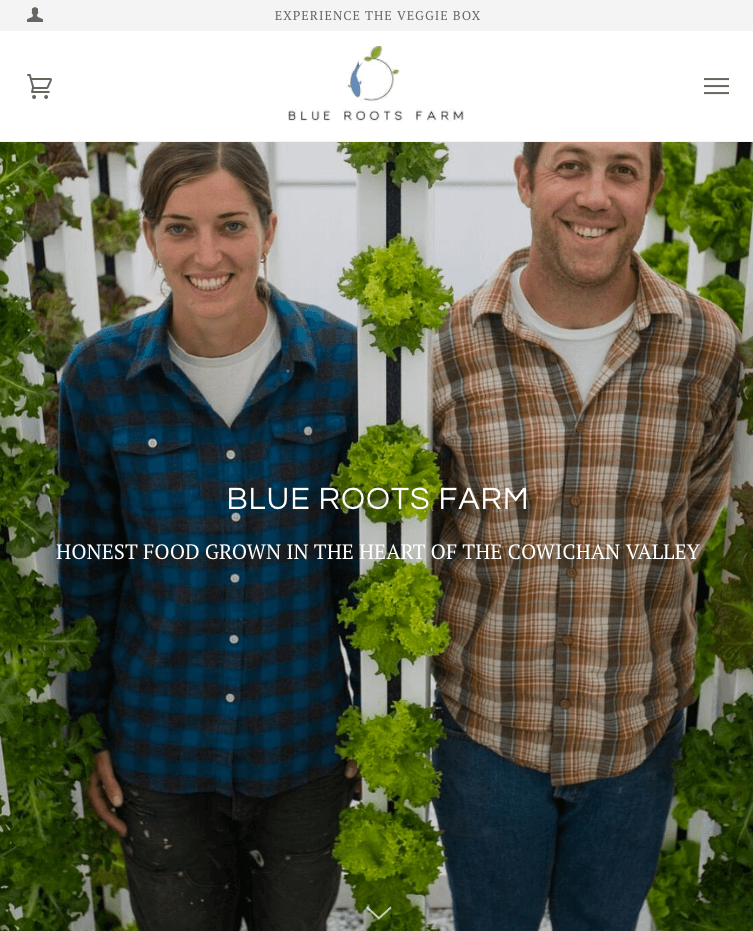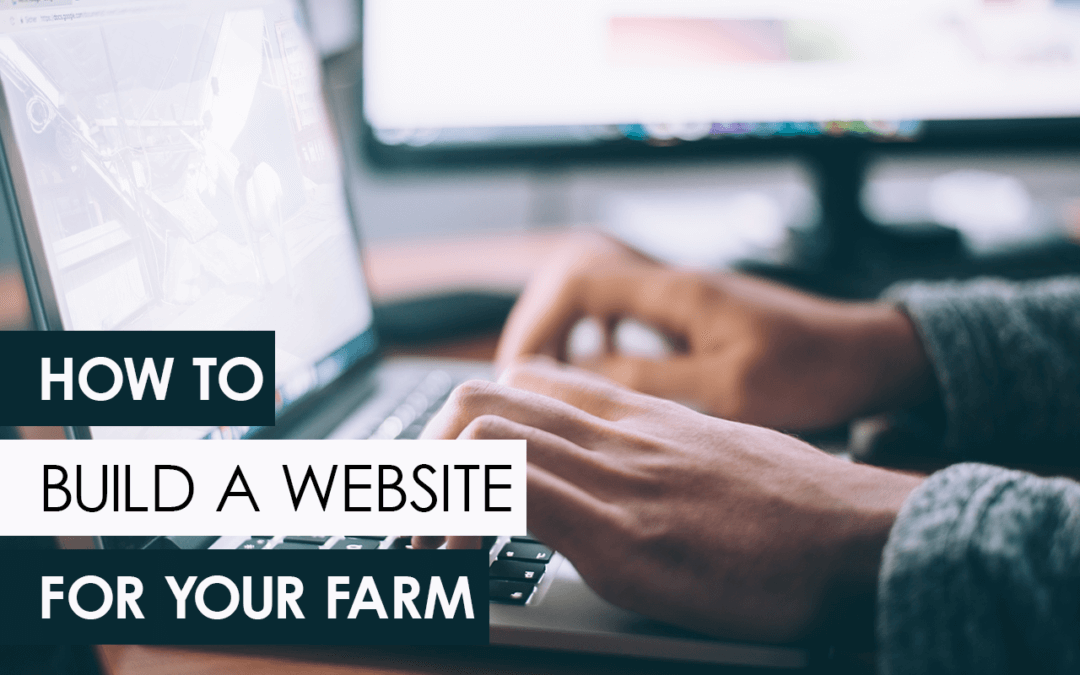Should I have a website?
Last week we discussed the pros and cons of having a farm website. If you’ve compared the costs and benefits of a website and decided that one is for you, then your next task is obvious: building out the site. Many farmers choose to hire a web developer to build a site for them. If that’s you, then you’ll still need to have a plan, preferences, and goals for your site so that you can guide a developer as they’re working for you.
This article will break down the basics of building a website so that even the most computer-illiterate farmer can make the first steps to a great web presence for their farm.
Set achievable goals
Your goals for your site will dictate how complex the site is (and how difficult the building process is!). Many new business owners aim too high with their first websites. By trying to accomplish too much, they lose focus for their website design and fall short of all their goals. Try to set reasonable, achievable goals.
Consider the typical goals for a farm’s website:
Advertising/Marketing: Any website will have this goal. Your website should be clean, intuitive, and represent the brand with which you’re hoping to saturate the market.
Updates: For those farmers growing especially seasonal crops, or for those selling at farmers’ markets, you’ll want part of your website to share information about product availability, vendor stall location and hours, and special offers.
Feedback: Providing a venue for customer feedback is an essential element of improving customer satisfaction. In practice, this is as simple as some contact information. Instead, consider the transparency your farm, and therefore the transparency of your website. Presenting your website as open and inviting will not only get you better feedback but make customers feel more comfortable with your produce and business model.
Partnerships: Farmers who are selling to groceries and restaurants will want to create an avenue for those markets to spread the good word about your farm. Consider the message that your partners are broadcasting, and how your website can act as a larger part of this unified advertising campaign.
Types of websites
There are a number of different ways to build a website.

The first is the traditional method: coding a website in HTML or some other programming language. Those farmers who already know a little something about coding or web design likely know the enormity of this task. If you aren’t a programmer or web developer, teaching yourself a whole new skill set for a website probably isn’t worth your precious time. We don’t recommend this method if you’ve never built a site before.

Have something in mind for your site layout? Sketch it out! Let your designer know exactly what you want.
The second option is easier for most farmers. Many different services offer pre-packaged websites for small business owners or private individuals. The most popular and accessible is likely WordPress, which we recommend for any farmers that want the bare necessities of a website. This type of website won’t look truly unique, but they will be approachable and easy to maintain. For the most part, with this sort of package, a farmer simply fills out forms, drops in photos, and does creative thinking for a nice website.
Finally, you could hire someone to build your website. This might sound expensive, but most farms won’t require an intricate website. Look for computer science students from local universities hoping for a little extra money, or put out a Craigslist advertisement asking for web developers. This shouldn’t run you more than $500, which is a small price to pay for the amount of work web design can take. Be sure to clearly express your goals and expectations for the website.
 Farm website examples
Farm website examples
Here are a few examples of some of our favorite farmers’ websites:
Colorado Fresh Farms – This website is probably a more reasonable first-website example. This website delivers a much more usable and realistic website for a small farmer. This page has all the salient bits: contact information, photos, a landing page, and plenty of helpful information.
Blue Roots Farm – Here we see some great examples of a specific type of outreach. We’ve discussed earlier that many restaurants and groceries are going to want to sell your story almost as much as your tasty produce. Blue Roots does a great job of being a tasteful, informative experience, and is designed to draw visitors who have encountered their product elsewhere.
Recommended website process
Assuming that you’re passably computer literate but have little experience creating a website, these are the steps that you will take when creating your site. Your budget and website needs might dictate some slight changes to this path.
1) Set your goals for the website
2) Choose one of the three options (Pre-built, Home-made, Contracted)
3) Establish a basic branding, advertising, and naming conventions
4) Purchase or rent a domain name
5) Website design
- Pre-built: Select the design for your pre-packaged website
- Contracted: Discuss the expectations and goals with your web designer, agree on a wage/price, and establish a timeline for delivery. Be patient and flexible. If you’re on a budget, expect to get what you pay for.
- Self-made: Create an outline of each page, begin drafting the individual pages, and implement your branding guides after establishing the skeleton of the site
6) After implementing the basic design, place content (contact info, advertising, locations) into proper pages
7) Ask friends and family to look at a draft of the website—use feedback to edit and tweak layout/content
8) Once satisfied with your website draft, publish the site onto your domain/hosted web server
9) Optional: Take out an ad in your paper, social media, etc. to take advantage of your website’s launch
>> Check out these 2020 Web Design Statistics so you can stay on top of the latest design trends<<
Frequently asked questions

What is a domain name?
A domain name is the title of a web page as seen by the rest of the internet. Owning your own domain is a bit like owning property in real life.
Should I get my own domain name?
Generally, yes. Most domains without too common of a name are going to be very affordable. If you’ve chosen to create a website from a prepackaged site, you’ll probably have a domain name that is associated with your web host.
Do I need special skills?
If you’re choosing a pre-built website, or contracting out and having someone else build your web page, you won’t need any skills other than a basic level of computer literacy to interact with your website. If you’re going to build your own, or heavily edit a pre-existing template, you’ll definitely want to become familiar with basic graphic design, web development, and programming.
What info needs to be there?
Your goals for the website might dictate some fancy additions, but a basic website needs your contact information, any information on your physical vendor stalls/location, a mission statement, and a basic introduction to your farm.
Should I sell online?
Probably not. Digital customers likely won’t be in the local area and will require huge logistical chains to deliver your product. A digital store will also require significant web development, maintenance, and troubleshooting. Unless you plan to run the majority of your business through your website, we recommend you avoid digital sales entirely.
Should I have a blog on my website?
Not if you’re a brand new farmer with a brand new farm. Take it from us—blogs take a lot of work. While most farmers can spare a few hours a week to upload photos or quick social media posts, a decent blog article can take a substantial amount of time. You should focus on the bare minimum of web-based responsibilities.
If you’re a veteran farmer or hoping to leverage the web as your primary method of marketing, then a blog might be worth your time.
Home away from home
Your farm’s website will be an essential part of your farm’s future. Building a website is no simple task, but with proper preparation, clear goals, and a little technical expertise, there’s nothing stopping even the most humble farm from finding a home on the website. Just remember to know your own limits. Consider the amount of time you’ll be able to allocate to your website and the number of funds you can dedicate to digital marketing.
If you’re thinking about whether your farm needs a website, read this companion article. For a full course on how to start a social media marketing campaign, check out our new course on Upstart University.



I am farmer in South Africa. I farm in livestock. I heard of you from my wife.
I would like to congratulate you on the good article titled “How to build a website for your farm”. I missed your last article on “pros and cons of having a farm website”. If you can, please share it with me.
Keep up the good work.
Kind regards
KD Matemane
+27 83 408 2710